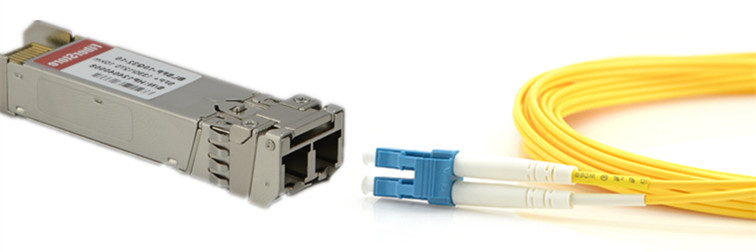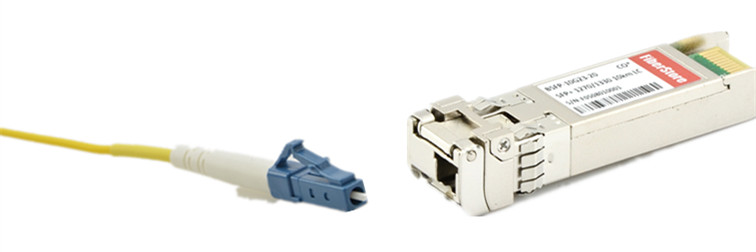Selecting 10G SFP+ Optics Modules and Patch Cables
Nowadays, 10G connection in telecommunication network is gradually moving from the backbone to layer 2 and layer 3. Both technology and market of 10G optics modules are mature: the 10G optics modules have advanced from XENPAK which is the first generation of 10G transceiver to SFP+ which is now the most popular 10G optics. In addition, the price of 10G modules is getting lower. 10G modules are becoming affordable. Some genius guys even buy 10 SFP+ modules or SFP+ cable online to DIY private point to point 10G network. This article will offer basic information about 10G SFP+ optics modules and their connection instructions.
10G SFP+ transceiver has the same form factor of Gigabit SFP transceiver. Thus, many SFP+ modules can support 1/10G data rate to increase its flexibility during practical using. A SFP+ transceiver usually has two LC ports (as shown in the following picture). While 10G BiDi SFP+ transceiver, which transmitting and receiving signals from the same fiber optic cable, only has one LC port.

Apart from fiber optic transceivers, there are also various factory terminated copper-based or fiber optic based cables which are terminated with a SFP+ module on each end of the cable. There are mainly three types of these 10G cables: 10G SFP+ passive direct attached copper cable (like HP J9283B), 10G active direct attached copper cable and 10G SFP+ active optical cable. These 10G cables eliminate the used of additional patch cable and can be directly plugged into the SFP+ ports on switches. It is acceptable that these cables are an cost-effective and reliable solutions for 10G connections in short distance.
According to IEEE standards, there are a variety 10GBASE SFP+ transceivers. For short distance transmission, 10GBASE-SR SFP+ and 10GBASE-LRM SFP+ can support transmission distance up to 300 meters and 220 meters over multimode fiber optic cables separately. 10GBASE-SR SFP+ modules is the most commonly used transceiver for short distance. It is suggested to work over wavelength of 850 nm.
There are a lot of 10G SFP+ transceivers that support long distance, like 10GBASE-LR SFP+, 10GBASE-ER SFP+, 10GBASE-ZR SFP+, CWDM SFP+, DWDM SFP+, BiDi SFP+, etc. These transceivers can support transmission distances ranging from 10 km to 120 km over single-mode fiber optic cables.
There is another special type of 10G SFP+ transceivers which has been mentioned in this post, which is known as dual-rate SFP+. For example, dual-rate 1000BASE-LX and 10GBASE-LR SFP+ transceiver can be adjusted to support both 1G and 10G data rate up to 10 km over wavelength of 1310 nm.

As 10G SFP+ DAC and AOC eliminate the using of additional patch cords. This part will introduce the selection guide for 10G SFP+ transceivers. During the selection of fiber optic patch cables for 10G transceivers, the transmission distance is the first element to be considered. Single-mode patch cable is used for long distance transmission and multimode is designed for short distance transmission. Then the ports on the transceiver for receiving and transmitting should be considered. As mentioned, most 10G SFP+ transceiver use duplex LC port, while BiDi SFP+ use simplex port. Thus, simplex LC patch cords or duplex LC patch cords are used according to the port type on the transceiver.
Although newer standards for higher speed, like 40Gbps and 100Gbps have already been launched, it can still be predicted that, 10G connections especially the SFP+ based optics and cables are bound to continue to dominate the market for the next 10 years or more.